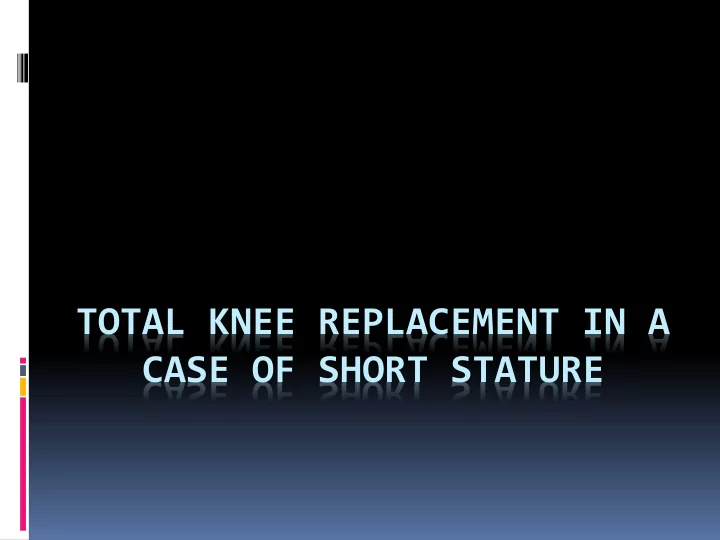

TOTAL KNEE REPLACEMENT IN A CASE OF SHORT STATURE
CHIEF COMPLAIN 65/F CAME TO OUR OPD WITH COMPLAIN OF PAIN IN LEFT KNEE SINCE ONE YEAR THERE WAS HISTORY OF TRAUMA ONE YEAR BACK
HISTORY OF PRESENT ILLNES PATIENT WAS APPARANTELY ALRIGHT ONE YEAR BACK WHEN SHE COMPLAINS OF PAIN IN LEFT KNEE. PAIN WAS SUDDEN IN ONSET GRADUALLY PROGRESSIVE, CONTINOUS, MODERATE, DIFFUSE, DULL-ACHING IN NATURE, NON- RADIATING WHICH AGGRAVATED ON WALKING AND RELIEVED ON TAKING REST
EXAMINATION Height: 133 cms Arm span: 136 cms US/LS ratio: 1.1 BMI: 24.3 Kg/m2
KNEE DIFFUSE TENDERNESS PRESENT OVER LEFT KNEE CREPITUS PRESENT (palpable friction) PATELLAR TAP NEGATIVE
PRE-OP RANGE OF MOTION: LT RT FLEXION 70 deg. 135 deg.
RADIOLOGICAL: Q angle: 17 degrees (normal range 10-20 degrees) Varus angle: 15 degrees (normal range < 10 degrees)
GRADE 3 POST TRAUMATIC ARTHRITIS OF LEFT KNEE
PRE-OP EVALUATION AND CHALLENGE Patient being a case of short stature our first and foremost challenge was to assess accurately the measurement of tibia and femur condyles Inability to do so could lead to abandoning the procedure in middle of surgery due to mismatch in size of implants Or it could lead to adverse post operative results
PRE OP EVALUATION-TEMPLATING METHOD Calculate actual measurement of an known object Then calculate the apparent measurement in the radiograph of the same object Magnification factor = actual measurement/apparent measurment
Next calculate the apparent measurement of condyles on the radiograph Multiply magnification factor with apparent mesurement of condyles Actual size of condyles = magnification factor * apparent measurement of condyles
PRE OP EVALUATION-TEMPLATING First modality used was x-ray Results: lateral to medial size of condyles 1. Femur-55.01mm 2. Tibia-57.9mm
Results: Anterior to posterior size of condyles 1. Tibia: 34.26mm 2. Femur: 42.72
TEMPLATING ON 128 SLICE CT SCAN RESULTS: Tibia: max. lateral to medial size of condyle is 64.0 mm
RESULTS: Tibia: max. anterior to posterior size of condyle is 39.9 mm
RESULTS: Femur: max. anterior to posterior size of condyle is 50.9 mm
RESULTS: Femur: max. lateral to medial size of condyle is 60.7 mm
CT MEASUREMENTS Tibia anteroposterior diameter : 39.9 mm lateral to medial diameter: 64 mm FEMUR anteroposterior diameter: 50.9 mm lateral to medial diameter: 60.7 mm
ADDED ADVANTAGE OF CT TEMPLATING Fracture fragment indicated by arrow was identified with its entire anatomy
IMPLANT COMPONENT SIZES AVAILABLE
INTRAOP IMPLANT SIZE USED FEMUR: AP: 53.5 mm ML: 63 mm TIBIA: AP: 40 mm ML:58 mm
COMPARISON IMPLANT CT SCAN X-RAY TIBIA(mm) AP 40 39.9 34.26 ML 58 64 57.9 FEMUR(mm) AP 53.5 50.9 42.72 ML 63 60.7 55.01
FEW INTRA-OP STEPS Fracture fragment being stabilised by k- wire
Securing of femoral zig
Femoral condyle cut
Additionally a STEM EXTENSION ROD of size 12.7mm*30mm was used to provide extra- stability in view of intra-articular tibia fracture
POST OP XRAY
POST OP RESULT • Complete extension achieved post operatively
• Patient able to achieve 12o degrees of range of motions post operatively
DISCUSSION IMPLANT CT SCAN X-RAY TIBIA(mm) AP 40 39.9 34.26 ML 58 64 57.9 FEMUR(mm) AP 53.5 50.9 42.72 ML 63 60.7 55.01
Knee arthroplasty can be a expensive affair for those who require customised components of implants Therefore to figure out preoperatively if the ready made implants are precise for a particular candidate or not various modalities can be used for example x-ray and CT scan
Thus which modality more precisely predicts the size of condyles becomes very essential, as it helps in preventing unnecessary need for customised implants. Customised implants being expensive can prevent unaffording candidate from receiving intervention which can have an adverse outcome in quality of life.
This case scenario gives us the insight to this important aspect of knee arthroplasty which needs furthur study to consolidate the outcome.
CONCLUSION CT Scan is more accurate overall in pre operative assesment of implant size to be used in total knee arthroplasty with average error of +/- 2.75 mm Xray is an inferior modality with average error of +/-6.04025 mm However point to be noted is Xray is a better modality in predicting medio-lateral size of tibia condyles
LIMITATIONS Intra observer error may be seen in measuring the accurate length Fracture of tibia plateau may have lead to error in measurement Exposure of radiation Affording patients can directly go ahead for custom made implants
Recommend
More recommend